The AMD Trinity Review (A10-4600M): A New Hope
by Jarred Walton on May 15, 2012 12:00 AM ESTAMD Trinity Gaming Performance
After the 3DMark results, you might be wondering if Intel has finally caught up to AMD in terms of integrated graphics performance. The answer is…yes and no. Depending on the game, there are times where a fast Ivy Bridge CPU with HD 4000 will actually beat out Trinity; there are also times where Intel’s IGP really struggles to keep pace. The good news is that at least everyone is now onboard the DX11 bandwagon, and compatibility with games has improved yet again for Intel. Here are our “Value” benchmark results for seven recent games; we’ll have more information in a moment.

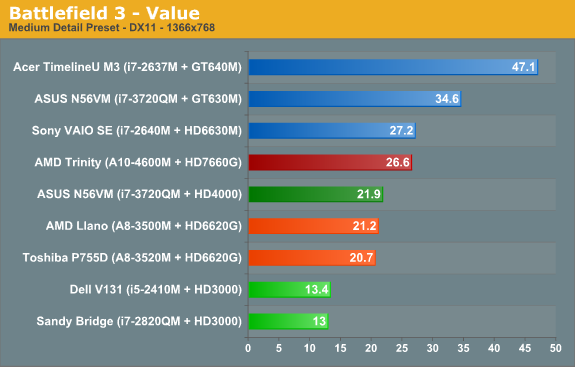
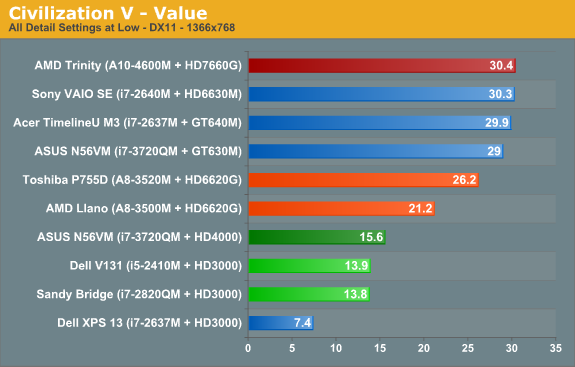

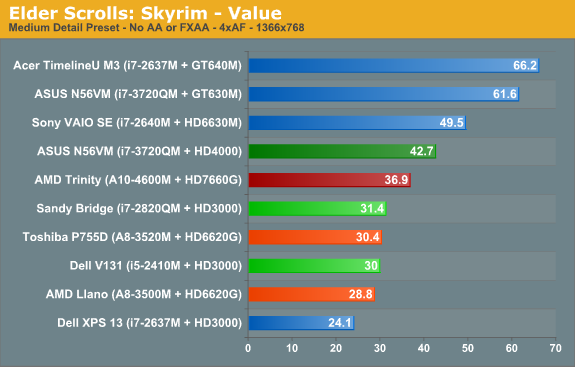
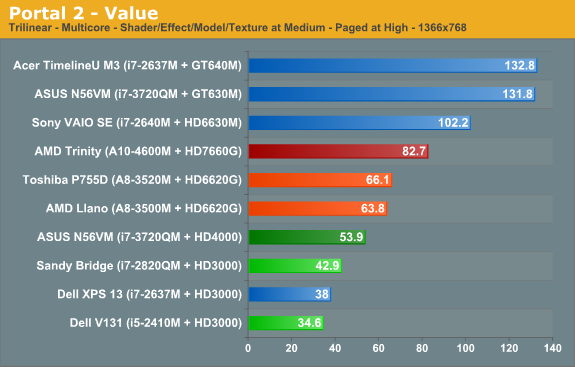
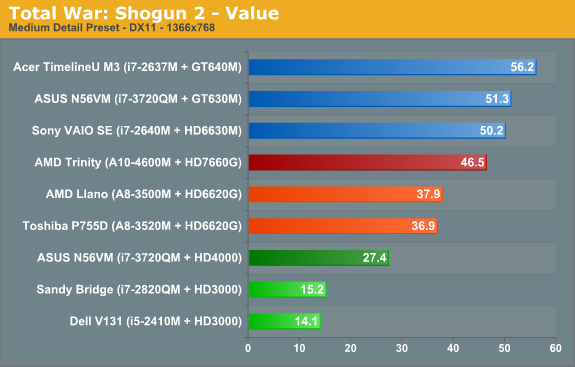
Out of our seven test titles, AMD’s Trinity leads any other IGP in four titles by a large margin. The other three titles actually have Ivy Bridge slightly ahead of Trinity, but the gaps aren’t nearly as big. Overall, the average performance across the seven games at our Value (medium) settings has AMD’s Trinity A10-4600M leading Intel’s i7-3720QM by 21%, and if we look at quad-core Sandy Bridge with HD 3000 (i7-2820QM) Trinity is 72% faster. Trinity is also around 20% faster than 35W Llano on average.
Let’s expand our gaming suite just a bit to see if things change, though. Just like we did with Ivy Bridge, we ran the eight games in our previous benchmark suite at medium detail settings. We can then compare performance across a wider 15 title selection to see how Trinity matches up against HD 4000, HD 3000, and HD 6620G (Llano). We’ll start with the bottom (HD 3000/Sandy Bridge) and move up.
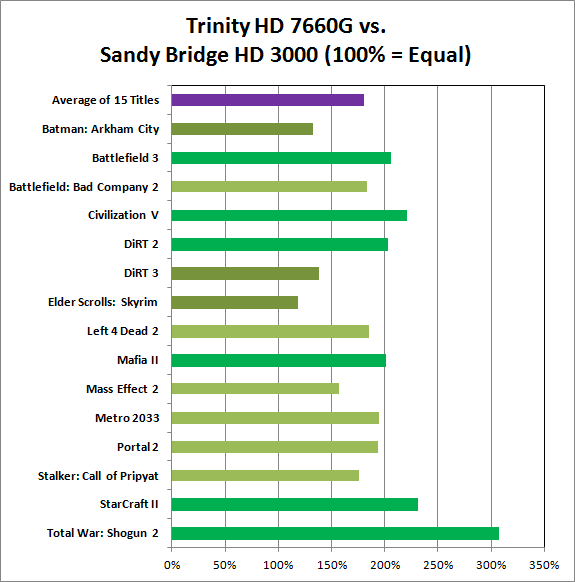
Llano’s HD 6620G was already faster than HD 3000, and Trinity’s HD 7660G is faster than Llano, so the Sandy Bridge gaming matchup is a landslide victory in AMD’s favor. The closest Intel can get is in the same three titles where Ivy Bridge leads Trinity: Batman: Arkham City, DiRT 3, and Skyrim. Here, however, HD 3000 can’t actually close the gap and HD 6620G is at least 20% faster than HD 3000, with an average performance improvement of nearly 80%.
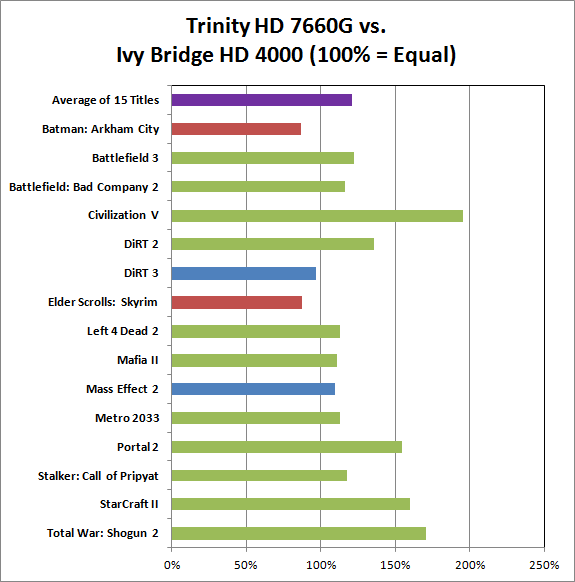
We found that across the same selection of 15 titles, Ivy Bridge and Llano actually ended up “tied”—Intel led in some games, AMD in others, but on average the two IGPs offered similar performance. This chart and the next chart will thus show a similar average increase in performance for Trinity, but the details in specific games are going to be different. Starting with Ivy Bridge and HD 4000, as with our earlier game charts we see there are some titles where Intel leads (Batman and Skyrim), a couple ties (DiRT 3 and Mass Effect 2), and the remainder of the games are faster on Trinity. Mafia II is close to our <10% “tie” range but comes in just above that mark, as do Left 4 Dead 2 and Metro 2033. The biggest gap is Civilization V, where Intel’s various IGPs have never managed good performance; Trinity is nearly twice as fast as Ivy Bridge in that title. Overall, it's a 20% lead for Trinity vs. quad-core Ivy Bridge.
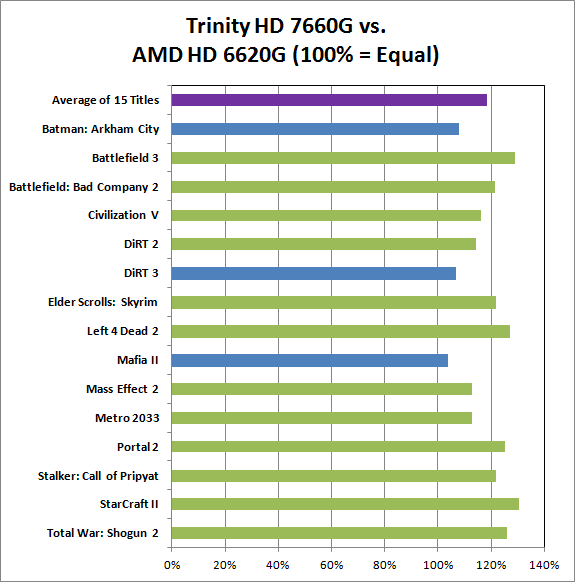
Against Llano, Trinity is universally faster, but the smallest gap is in Mafia II (3%) while the largest gap is in StarCraft II (30%). On average, looking at these games Trinity is only 18% faster than Llano. What’s not entirely clear from the above chart is whether we’re hitting CPU limitations, memory bandwidth limitations (remember that Llano and Trinity share bandwidth with the rest of the system), or perhaps both. At our chosen settings, what is clear is that Trinity’s “up to 56% faster” graphics never make it that high.
We saw 35-45% higher scores in 3DMark 11 and Vantage, which tend to remove the CPU from the equation more than actual games, so our guess would be that if AMD continues with their APU plan they’re going to need to work more on the CPU side of the equation. We also see the same thing looking at the VAIO SE scores in the earlier gaming charts: the HD 6630M scores are 20% faster on average, but much of that appears to come from the faster CPU rather than the GPU.










271 Comments
View All Comments
codedivine - Tuesday, May 15, 2012 - link
Does the GPU support fp64?JarredWalton - Tuesday, May 15, 2012 - link
I would assume so, though like most consumer GPUs it's going to be 1/16 FP32 performance or something similarly dire. If you have a quick test I could run, I'll be happy to report back.codedivine - Tuesday, May 15, 2012 - link
Thanks. Can you post the relevant output from "clinfo.exe"? This utility should either be part of new Catalyst releases, or you can alternately install AMD's APP SDK and it is a prebuilt utility. This will list a lot things, including extensions supported in OpenCL. It will show two devices available: one for CPU and one for GPU. If the GPU side lists cl_khr_fp64 (or the less-compliant cl_amd_fp64) then it supports FP64 in OpenCL.Not sure about how to test the rate.
JarredWalton - Tuesday, May 15, 2012 - link
Both cl_khr_fp64 and cl_amd_fp64 are listed as supported on both the CPU and GPU. Full CLinfo output is available here:http://images.anandtech.com/reviews/mobile/Trinity...
codedivine - Tuesday, May 15, 2012 - link
That is great! Your help is greatly appreciated!So I guess I am buying a Trinity then, as it will simplify my OpenCL development workflow.
Sidenote: I have some OpenCL code under development (as part of my grad research) that might be useful for you for benchmarking purposes for as well. Will get back to you about that in a few weeks.
JarredWalton - Tuesday, May 15, 2012 - link
Cool -- I'd love to see more OpenCL benchmarks, especially if they're actually meaningful to other people!GullLars - Tuesday, May 15, 2012 - link
This may not be relevant, but i think the next generation APU with GCN graphics architecture is where we will really start to see a benefit of using GPGPU on mainstream integrated GPUs.Various GPGPU benchmarks show a signifficant increase going from VLIW4 to GCN.
I hope to get into openCL, GPGPU and parallel programming too at a later point. Currently i'm styding a BS in Computer Engineering; Embedded Systems. I love it, as it gives insight into both software and hardware at all levles from logic gates to complete systems.
Brutalizer - Tuesday, July 10, 2012 - link
WOW! Does the Trinity only have two cores? That is brutal!AMD's version of hyperthreading is a piledriver core: it has duplicated several components which is much better than Intel hyperthreading. So one piledriver core, corresponds to one Intel core with hyper threading.
So, what Anandtech is actually testing, is four Intel core cpus, vs two AMD core cpus. There is no surprise that four cores beats two cores, but the cool thing is that AMD two cores does very well compared to four Intel cores!
If I was AMD, I would say that the Trinity only has two cores, and still it gives a four core Intel cpu a match! That is much better marketing than claiming Trinity is four cores (which is not) and get beaten by Intel four core cpus.
moozoo - Tuesday, May 15, 2012 - link
Thanks!I too was after the CLInfo for trinity to find out its fp64 support.
MySchizoBuddy - Tuesday, May 15, 2012 - link
so it only supports OpenCL 1.1 not the newer 1.2